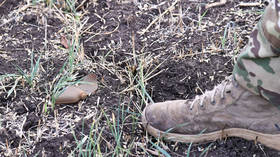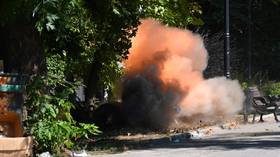Here’s why Human Rights Watch deliberately only scratched the surface in exploring Ukraine’s use of banned ‘petal’ mines

Since Ukraine dropped thousands of mines on the Donetsk People’s Republic (DPR) in July, 104 people have fallen victim to the internationally-banned PFM-1 ‘petal’ (otherwise known as ‘butterfly’) devices. Nine of them are children. Of which three died.
Among the most recent civilians to be injured, on March 19, were two 60-year-old men. On February 26, a woman in her sixties was wounded in her neighborhood. On February 14, a teenager stepped on a petal mine near a school. These are just a few documented examples from recent weeks.
The first wave of over 40 victims came within the first few weeks after Ukrainian forces deployed the mines over Donetsk en masse in July 2022, and the number has more than doubled since. Since then I, along with other reporters on the ground, have documented their lingering presence and the civilian victims.
NGO reports... selectively
After signing the 1997 Mine Ban Treaty in 1999, Kiev was obligated to destroy its stockpile of 6 million PFM-1s. It denies using them, but abundant evidence incriminates Kiev in this particular war crime. While the West has yet to turn its attention to the victims of the petal mines in the Donbass, reports of Ukraine using them elsewhere have emerged.
NPR article on HRW finally confirming Ukraine's use of prohibited "petal mines" which are killing civilians including children - what REAL journalists like @EvaKBartlett have reported for months now. pic.twitter.com/TjyJ6MqewG
— Brian Berletic (@BrianJBerletic) February 3, 2023
In its January 2023 report on banned landmines, the Human Rights Watch NGO notes, “In 2021, Ukraine reported to the UN secretary-general that 3.3 million stockpiled PFM mines still need to be destroyed.” HRW then advised Ukraine to investigate itself for its use of the prohibited mines.
The report is titled “Ukraine: Banned Landmines Harm Civilians. Ukraine Should Investigate Forces’ Apparent Use; Russian Use Continues,” implying that not only is Russia also deploying the petal mines, but that Russia’s use of them is beyond question, while Kiev’s use is open to debate.
Yet, much like in 2020, when the UN accused Russia of war crimes in Syria based on “we say so” and unnamed sources, you won’t find proof of Russia’s use of petal mines in the HRW report. In fact, buried there is a HRW admission that it “has not verified claims of Russian forces using PFM mines in the armed conflict.” This is a standard media tactic: boldly state one thing in a headline and quietly clarify the opposite in the body of the article, which most people won't bother reading.
On the other hand, HRW claims it interviewed over 100 people, “including witnesses to landmine use, victims of landmines, first responders, doctors, and Ukrainian de-miners,” regarding Ukraine's use of the objects in Izium (a city in the Kharkov region, north of Donetsk) while it was briefly under Moscow’s control. The HRW team entered the city after Russian forces withdrew in September. Everyone interviewed, the report noted, “said they had seen mines on the ground, knew someone who was injured by one, or had been warned about their presence during Russia’s occupation of Izium.”
The testimony records that the areas were all, “close to where Russian military forces were positioned at the time, suggesting they were the target,” and that residents in Izium said that rocket attacks, “happened frequently during the Russian occupation.”
The report cited 11 civilian mine-casualties, and noted that HRW had seen “physical evidence of PFM antipersonnel mine use,” including, “unexploded mines, remnants of mines, and the metal cassettes that carry the mines in rockets.”
It has to be noted that HRW has been banned in Russia since April 2022, making it impossible for the organization to gather evidence on the ground in areas controlled by Russian forces. However, lack of access to evidence has not stopped it from using its report to carry accusations against Russia, citing Ukraine’s former prosecutor general Irina Venediktova’s claim that “Russian forces used PFM mines in the Kharkivska region as early as February 26”. In contrast, the numerous credible reports of Kiev’s use of petal mines in Donetsk, available through open sources, are absent from the report.
HRW’s history of targeted condemnations
Human Rights Watch is one of many Western-funded NGOs with a history of whitewashing NATO and its allies' crimes while pretending to be a neutral observer. Over the years, I've pointed out the hypocrisy of Ken Roth, who was the George Soros-funded NGO’s executive director from 1993-2022. In March 2021 he pushed Washington's propaganda about Russia starving Syria. More glaringly, in 2015, Roth used footage from an eastern Gaza neighbourhood (Shuja’iyya) that had been flattened by Israel, to claim the footage depicted Syria's Aleppo. He went on to likewise push the 2013 Ghouta “chemical” narrative, which had long been widely-discredited by journalists and by the so-called “rebels” themselves.
If dubious claims from HRW or its representatives aren't indication enough of their allegiances to Western narratives, then their links to the US government should be. The vice chair of its board of directors, Susan Manilow, according to this 2014 article, describes herself as “a longtime friend to Bill Clinton,” who helped manage his campaign finances. Bruce Rabb, also on the board, lists in his biography that he “served as staff assistant to President Richard Nixon” from 1969-70 – the period in which his administration secretly and illegally carpet-bombed Cambodia and Laos.
The article further notes that the advisory committee for HRW’s Americas Division has even boasted the presence of a former Central Intelligence Agency official, Miguel Díaz. According to his State Department biography, Díaz served as a CIA analyst and also provided “oversight of US intelligence activities in Latin America” for the House Permanent Select Committee on Intelligence.
So, when HRW recently decided to finally discuss Ukraine's deployment of the insidious petal mines (tens of thousands of which have been fired into the Donbass by Ukraine over the course of the past year), it is not because the body has suddenly become neutral and impartial, but it is rather a grasp at credibility: reporting what is widely known – that, in violation of international law, Ukraine has been deploying Petal mines – but avoid providing the whole story.
By downplaying and ignoring Kiev's widespread use of petal mines throughout the DPR, HRW is deliberately downplaying war crimes, much like the entirety of Western corporate media.
Kiev’s Western supporters may even have to deal with its use of the petal mines at their own expense down the line – Canadian Prime Minister Justin Trudeau has recently announced his country would invest $2.2 million into de-mining Ukraine. Of course, no mention was made of the Ottawa Treaty-banned munitions which will have to be cleared.
Kiev’s deadly delivery
In one incident I witnessed first hand, an attack took place just after 9 pm on July 30, 2022. Ukraine fired rockets, each packed with over 300 mines, onto Donetsk, its suburbs, and other cities, including Yasinovataya, Makeevka and Gorlovka. The rockets exploded in the air to ensure greater distribution of devices on the ground. The attack mirrored previous ‘deliveries’ to the hard-hit Donetsk districts of Kievskiy, Kirovsky and Kuibyshevkiy.
The morning after, I walked the central Donetsk streets extremely carefully, wary of every leaf or piece of cardboard which could be obscuring or covering a Petal mine, so difficult are they to pick out from their surroundings. They cannot seriously damage military vehicles, which means that scattering them over Donetsk only has one purpose – to target and maim civilians. Some models of the petal mines have a self-destruct timer. Others, including those used by Kiev, can stay on the ground for years.
The innocent victims of Donbass
Since reporting the initial bombardment in late July, I have been following up on the methodical destruction of these mines by Russian sappers, as well as on civilians harmed by the illegal munitions. One of the more recent victims was 14 year old Nikita. His foot was blown off when in early November, 2022, he stepped on a mine in a playground while on his way to visit his grandmother.
RT journalist Roman Kosarev recently spoke with another recent teenage victim, who stepped on a petal mine when getting into a car.
Kosarev also spoke to the Director of the Donetsk Republic’s Trauma Center, Andrey Boryak, who said: "The injury from such a mine is very severe, and immediately leads to a handicap. It's almost impossible to save the foot and the lower part of the leg.”
This is what I've been reporting since late July when Ukraine fired rockets containing petal mines (300+/rocket) all over Donetsk & other cities: they're often impossible to see, even if you've been warned of their presence. https://t.co/DMab8myVnd
— Eva Karene Bartlett (@EvaKBartlett) January 24, 2023
HRW has had over 6 months to investigate Ukraine littering the DPR with Petal/PFM-1 mines… but it has not, and will not. It's once again the case that the lives of Donbass civilians don't matter when it comes not only to Western media reporting but also to supposedly-neutral human rights bodies. Even worse still is the knowledge that in spite of the valiant efforts of sappers in the DPR, the mines will inevitably claim more innocent civilians as their victims.
The statements, views and opinions expressed in this column are solely those of the author and do not necessarily represent those of RT.















